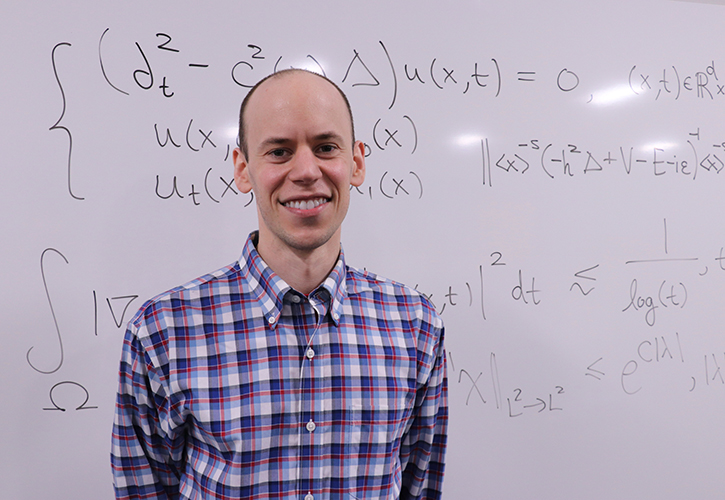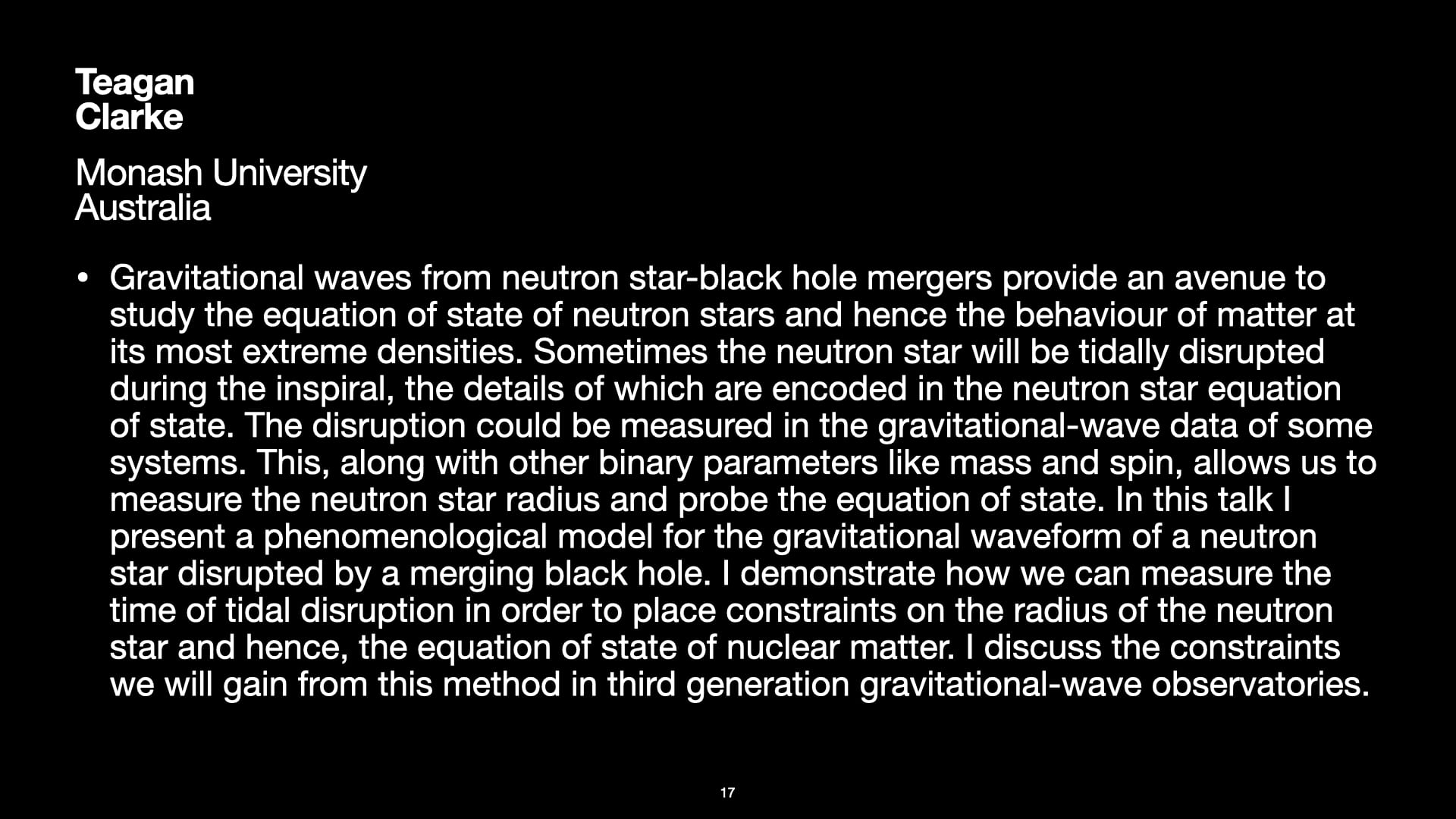Dr Volker Schlue
We show global existence backward from scattering data at infinity for semilinear wave equations satisfying the null condition or the weak null condition. Semilinear terms satisfying the weak null condition appear in many equations in physics. The scattering data is given in terms of the radiation field, although in the case of the weak null condition there is an additional logarithmic term in the asymptotic behavior that has to be taken into account. Our results are sharp in the sense that the solution has the same spatial decay as the radiation field does along null infinity, which is assumed to decay at a rate that is consistent with the forward problem. The proof uses a higher order asymptotic expansion together with a new fractional Morawetz estimate with strong weights at infinity.
This paper is motivated by the non-linear stability problem for the expanding region of Kerr de Sitter cosmologies in the context of Einstein's equations with positive cosmological constant. We show that under dynamically realistic assumptions the conformal Weyl curvature of the spacetime decays towards future null infinity. More precisely we establish decay estimates for Weyl fields which are (i) uniform (with respect to a global time function) (ii) optimal (with respect to the rate) and (iii) consistent with a global existence proof (in terms of regularity). The proof relies on a geometric positivity property of compatible currents which is a manifestation of the global redshift effect capturing the expansion of the spacetime.
This paper addresses pure gauge questions in the study of asymptotically de Sitter spacetimes. We construct global solutions to the eikonal equation on de Sitter, whose level sets give rise to double null foliations, and give detailed estimates for the structure coefficients in this gauge. We show two results that are relevant for the foliations used by the author in the context of the stability problem of the expanding region of Schwarzschild de Sitter spacetimes: (i) Small perturbations of round spheres on the cosmological horizons lead to spheres that pinch off at infinity. (ii) Globally well-behaved double null foliations can be constructed from infinity using a choice of spheres related to the level sets of a new mass aspect function. While (i) shows that in the above stability problem a final gauge choice is necessary, the proof of (ii) already outlines a strategy for the case of spacetimes with decaying, instead of vanishing, conformal Weyl curvature.
We study spherically symmetric solutions to the Einstein–Euler equations which model an idealised relativistic neutron star surrounded by vacuum. These are barotropic fluids with a free boundary, governed by an equation of state which sets the speed of sound equal to the speed of light. We demonstrate the existence of a 1-parameter family of static solutions, or “hard stars” and describe their stability properties: First, we show that small stars are a local minimum of the mass energy functional under variations which preserve the total number of particles. In particular, we prove that the second variation of the mass energy functional controls the “mass aspect function”. Second, we derive the linearisation of the Euler–Einstein system around small stars in “comoving coordinates” and prove a uniform boundedness statement for an energy, which is exactly at the level of the variational argument. Finally, we exhibit the existence of time-periodic solutions to the linearised system, which shows that energy boundedness is optimal for this problem.
We prove that smooth asymptotically flat solutions to the Einstein vacuum equations which are assumed to be periodic in time, are in fact stationary in a neighborhood of infinity. Our result applies under physically relevant regularity assumptions purely at the level of the initial data. In particular, our work removes the assumption of analyticity up to null infinity in Biˇc´ak, Scholtz, and Tod [2010]. The proof relies on extending a suitably constructed “candidate” Killing vector field from null infinity, via Carlemantype estimates obtained in Alexakis, Schlue, and Shao [2013].
We prove various uniqueness results from null infinity, for linear waves on asymptotically flat space–times. Assuming vanishing of the solution to infinite order on suitable parts of future and past null infinities, we derive that the solution must vanish in an open set in the interior. We find that the parts of infinity where we must impose a vanishing condition depend strongly on the background geometry. In particular, for backgrounds with positive mass (such as Schwarzschild or Kerr), the required assumptions are much weaker than the ones in the Minkowski space–time. The results are nearly optimal in many respects. They can be considered analogues of uniqueness from infinity results for second order elliptic operators. This work is partly motivated by questions in general relativity.
In this global study of solutions to the linear wave equation on Schwarzschild de Sitter spacetimes we attend to the cosmological region of spacetime which is bounded in the past by cosmological horizons and to the future by a spacelike hypersurface at infinity. We prove an energy estimate capturing the expansion of that region, which combined with earlier results for the static region, yields a global boundedness result for linear waves. It asserts that a general finite energy solution to the global initial value problem has a limit on the future boundary at infinity that can be viewed as a function on the standard cylinder with finite energy, and that, moreover, any decay along the cosmological horizon is inherited along the future boundary. In particular, we exhibit an explicit nonvanishing quantity on the future boundary of the spacetime consistent with our expectations for the nonlinear stability problem. Our results apply to a large class of expanding cosmologies near the Schwarzschild de Sitter geometry, in particular subextremal Kerr de Sitter spacetimes.
We consider solutions to the linear wave equation on higher dimensional Schwarzschild black hole spacetimes and prove robust nondegenerate energy decay estimates that are in principle required in a nonlinear stability problem. More precisely, it is shown that for solutions to the wave equation on the domain of outer communications of the Schwarzschild spacetime manifold the associated energy flux through a foliation of hypersurfaces decays, E[φ](Σ(τ))≤ CD/τ², where C is a constant, and D is a suitable higher-order initial energy on Σ(0); moreover we improve the decay rate for the first-order energy. We conclude our paper by interpolating between these two results to obtain the pointwise estimate |φ|≤ C D'/τ³⁄²−δ. In this work we follow the new physical-space approach to decay for the wave equation of Dafermos and Rodnianski (2010).

UD mathematician awarded Fulbright for research in Australia : University of Dayton, Ohio

Julia Büchting on LinkedIn: #tableau #data #tug #marketing #dashboard

Cambridge Classical Studies) Geue, Tom - Juvenal and The Poetics of Anonymity-Cambridge University Press (2017), PDF, Satire

Dr. Damian Daniluk - Team Lead Business Operations - Phoenix Contact GmbH & Co. KG

Universität Paderborn - News item - Fakultät für Naturwissenschaften feiert Absolvent*innen

Bernhard BREIL, Professor (Full), Professor, University Hochschule Niederrhein, Krefeld, HSNR, Faculty of Health Care

2023 Australia-NZ Student Conference on Relativity / Cosmology / Astrophysics – New Zealand Gravity

Colloquia, Department of Mathematics, College of Arts and Sciences

LunchMaths at Monash University

Christlicher Gesundheitskongress 2014 (Programm)
Scattering from infinity for semi-linear wave equations with weak null condition - TIB AV-Portal

Reporter, issue 303 – 23 May 2017 by Imperial College London - Issuu

LunchMaths at Monash University

Viruses, Free Full-Text

Subjects - Summer School 2024